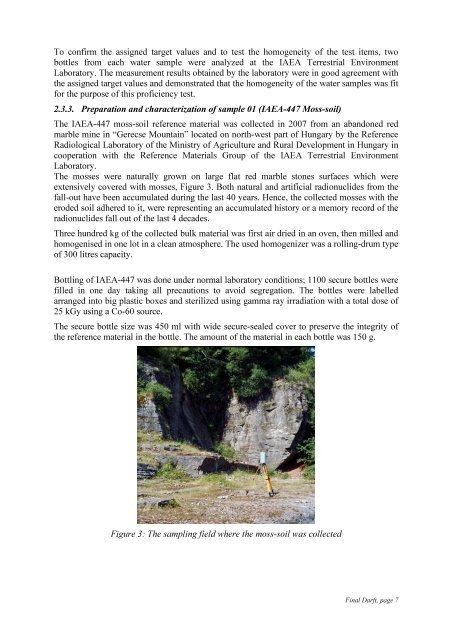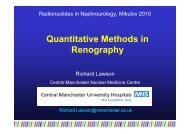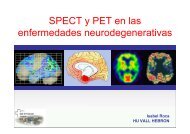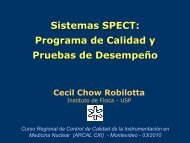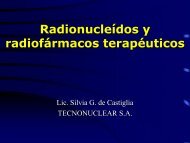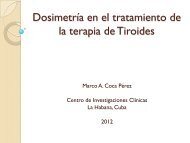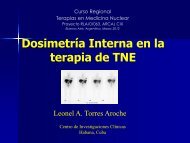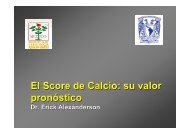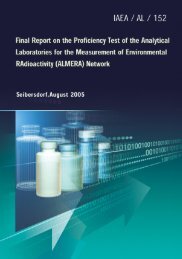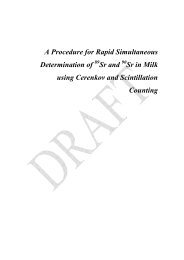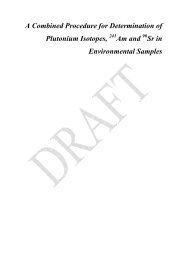- Page 1 and 2: IAEA Analytical Quality in Nuclear
- Page 3 and 4: FOREWORD A reliable determination o
- Page 5 and 6: 1. INTRODUCTION A reliable determin
- Page 7: 2.1. Proficiency test objectives 2.
- Page 11 and 12: program achieving complete sample d
- Page 13 and 14: 2.3.4.3. Determination of U-234, U-
- Page 15 and 16: AlphaCounts per channel 2000 1500 1
- Page 17 and 18: 3. PERFORMANCE CRITERIA Several rat
- Page 19 and 20: acceptable”, a further check is a
- Page 21 and 22: TABLE 4. SUMMARY EVALUATION OF ALL
- Page 23 and 24: Lab. code Number of reported Scored
- Page 25 and 26: Lab. code Number of reported Scored
- Page 27 and 28: Lab. code Number of reported Scored
- Page 29 and 30: 4.2. General recommendations and le
- Page 31 and 32: Difference S2-S4 (%) Difference S2-
- Page 33 and 34: 4.4. Recommendations related to the
- Page 35 and 36: [Bq/kg] 70 60 50 40 30 20 10 0 Ra-2
- Page 37 and 38: Figure 22: Part of the Thorium radi
- Page 39 and 40: 5. CONCLUSIONS The IAEA-CU-2009-03
- Page 41 and 42: REFERENCES [1] DUEWER, D.L., A Robu
- Page 43 and 44: APPENDIX I: PERFORMANCE EVALUATION
- Page 45 and 46: Lab code Rep. Value Rep. Unc. Unc.
- Page 47 and 48: Lab code Rep. Value Rep. Unc. Unc.
- Page 49 and 50: Lab code Rep. Value Rep. Unc. Unc.
- Page 51 and 52: Lab code Rep. Value Rep. Unc. Unc.
- Page 53 and 54: Lab code Rep. Value Rep. Unc. Unc.
- Page 55 and 56: Lab code Rep. Value Rep. Unc. Unc.
- Page 57 and 58: Lab code Rep. Value Rep. Unc. Unc.
- Page 59 and 60:
Lab code Rep. Value Rep. Unc. Unc.
- Page 61 and 62:
Lab code Rep. Value Rep. Unc. Unc.
- Page 63 and 64:
Lab code Rep. Value Rep. Unc. Unc.
- Page 65 and 66:
Lab code Rep. Value Rep. Unc. Unc.
- Page 67 and 68:
[Bq/kg] 650 575 500 425 350 275 200
- Page 69 and 70:
[Bq/kg] 650 600 550 500 450 400 350
- Page 71 and 72:
[ B q /k g ] 70 60 50 40 30 20 10 L
- Page 73 and 74:
Lab code Rep. Value Rep. Unc. Unc.
- Page 75 and 76:
Lab code Rep. Value Rep. Unc. Unc.
- Page 77 and 78:
Lab code Rep. Value Rep. Unc. Unc.
- Page 79 and 80:
Lab code Rep. Value Rep. Unc. Unc.
- Page 81 and 82:
Lab code Rep. Value Rep. Unc. Unc.
- Page 83 and 84:
Lab code Rep. Value Rep. Unc. Unc.
- Page 85 and 86:
Lab code Rep. Value Rep. Unc. Unc.
- Page 87 and 88:
Lab code Rep. Value Rep. Unc. Unc.
- Page 89 and 90:
Lab code Rep. Value Rep. Unc. Unc.
- Page 91 and 92:
Lab code Rep. Value Rep. Unc. Unc.
- Page 93 and 94:
[Bq] 50 45 40 35 30 25 20 15 10 120
- Page 95 and 96:
[Bq/kg] 60 50 40 30 20 10 0 25 223
- Page 97 and 98:
Lab code Rep. Value Rep. Unc. Unc.
- Page 99 and 100:
Lab code Rep. Value Rep. Unc. Unc.
- Page 101 and 102:
[ B q /k g ] 60 50 40 30 20 10 0 72
- Page 103 and 104:
Lab code Rep. Value Rep. Unc. Unc.
- Page 105 and 106:
Lab code Rep. Value Rep. Unc. Unc.
- Page 107 and 108:
Lab code Rep. Value Rep. Unc. Unc.
- Page 109 and 110:
Lab code Rep. Value Rep. Unc. Unc.
- Page 111 and 112:
Lab code Rep. Value Rep. Unc. Unc.
- Page 113 and 114:
Lab code Rep. Value Rep. Unc. Unc.
- Page 115 and 116:
Lab code Rep. Value Rep. Unc. Unc.
- Page 117 and 118:
[Bq/kg] 15 13 11 9 7 5 3 1 74 131 2
- Page 119 and 120:
Lab code Rep. Value Rep. Unc. Unc.
- Page 121 and 122:
Lab code Rep. Value Rep. Unc. Unc.
- Page 123 and 124:
[Bq/kg] 45 41 37 33 29 25 21 17 13
- Page 125 and 126:
Lab code Rep. Value Rep. Unc. Unc.
- Page 127 and 128:
Lab code Rep. Value Rep. Unc. Unc.
- Page 129 and 130:
Lab code Rep. Value Rep. Unc. Unc.
- Page 131 and 132:
Lab code Rep. Value Rep. Unc. Unc.
- Page 133 and 134:
Lab code Rep. Value Rep. Unc. Unc.
- Page 135 and 136:
Lab code Rep. Value Rep. Unc. Unc.
- Page 137 and 138:
Lab code Rep. Value Rep. Unc. Unc.
- Page 139 and 140:
[Bq/kg ] 19 17 15 13 11 9 7 5 3 286
- Page 141 and 142:
Lab code Rep. Value Rep. Unc. Unc.
- Page 143 and 144:
Lab code Rep. Value Rep. Unc. Unc.
- Page 145 and 146:
Lab code Rep. Value Rep. Unc. Unc.
- Page 147 and 148:
Lab code Rep. Value Rep. Unc. Unc.
- Page 149 and 150:
Lab code Rep. Value Rep. Unc. Unc.
- Page 151 and 152:
Lab code Rep. Value Rep. Unc. Unc.
- Page 153 and 154:
[Bq/kg] 19 17 15 13 11 9 7 5 3 1 25
- Page 155 and 156:
Lab code Rep. Value Rep. Unc. Unc.
- Page 157 and 158:
Lab code Rep. Value Rep. Unc. Unc.
- Page 159 and 160:
[ B q /k g ] 5.5 5 4.5 4 3.5 3 2.5
- Page 161 and 162:
Lab code Rep. Value Rep. Unc. Unc.
- Page 163 and 164:
Lab code Rep. Value Rep. Unc. Unc.
- Page 165 and 166:
[ B q /k g ] 3.5 3.0 2.5 2.0 1.5 1.
- Page 167 and 168:
Lab code Rep. Value Rep. Unc. Unc.
- Page 169 and 170:
Lab code Rep. Value Rep. Unc. Unc.
- Page 171 and 172:
[Bq /kg ] 8.5 7.5 6.5 5.5 4.5 3.5 2
- Page 173 and 174:
Lab code Rep. Value Rep. Unc. Unc.
- Page 175 and 176:
Lab code Rep. Value Rep. Unc. Unc.
- Page 177 and 178:
Lab code Rep. Value Rep. Unc. Unc.
- Page 179 and 180:
Lab code Rep. Value Rep. Unc. Unc.
- Page 181 and 182:
Lab code Rep. Value Rep. Unc. Unc.
- Page 183 and 184:
Lab code Rep. Value Rep. Unc. Unc.
- Page 185 and 186:
[Bq/kg] 7.5 6.5 5.5 4.5 3.5 2.5 1.5
- Page 187 and 188:
Lab code Rep. Value Rep. Unc. Unc.
- Page 189 and 190:
Lab code Rep. Value Rep. Unc. Unc.
- Page 191 and 192:
[B q /k g ] 13 11 9 7 5 3 1 515 26
- Page 193 and 194:
Lab code Rep. Value Rep. Unc. Unc.
- Page 195 and 196:
Lab code Rep. Value Rep. Unc. Unc.
- Page 197 and 198:
[Bq /kg ] 11 9 7 5 3 1 219 250 233
- Page 199 and 200:
Lab code Rep. Value Rep. Unc. Unc.
- Page 201 and 202:
Lab code Rep. Value Rep. Unc. Unc.
- Page 203 and 204:
Lab code Rep. Value Rep. Unc. Unc.
- Page 205 and 206:
Lab code Rep. Value Rep. Unc. Unc.
- Page 207 and 208:
Lab code Rep. Value Rep. Unc. Unc.
- Page 209 and 210:
Lab code Rep. Value Rep. Unc. Unc.
- Page 211 and 212:
[Bq/kg] 13 11 9 7 5 3 1 273 5264 26
- Page 213 and 214:
Lab code Rep. Value Rep. Unc. Unc.
- Page 215 and 216:
Lab code Rep. Value Rep. Unc. Unc.
- Page 217 and 218:
Lab code Rep. Value Rep. Unc. Unc.
- Page 219 and 220:
Lab code Rep. Value Rep. Unc. Unc.
- Page 221 and 222:
Lab code Rep. Value Rep. Unc. Unc.
- Page 223 and 224:
Lab code Rep. Value Rep. Unc. Unc.
- Page 225 and 226:
APPENDIX II: LIST OF PARTICIPATING
- Page 227 and 228:
Dr. Victor Badulin Public Exposure
- Page 229 and 230:
Dr. David Lobb Department of Soil S
- Page 231 and 232:
Petr Rulik Monitoring Department Na
- Page 233 and 234:
Mr. Benoit Daniel Eichrom Europe Ru
- Page 235 and 236:
Prof. Dr. Constantin Papastefanou A
- Page 237 and 238:
Mr. A.G. Hegde Health Physics Divis
- Page 239 and 240:
Mr. Mario Montalto Istituto Di Radi
- Page 241 and 242:
Mr. Samer J. Al-Kharouf Radiation P
- Page 243 and 244:
Ms. Snezana Dimovska Radioecology R
- Page 245 and 246:
Dr. Andrzej Komosa Department of Ra
- Page 247 and 248:
Ms. Ana-Maria Apostu Dept. of Life
- Page 249 and 250:
Mr. Peter Jovanovic Department of P
- Page 251 and 252:
Dr. Catalina Gasco Leonarte Ed. 3a
- Page 253 and 254:
Dra. Montserrat Llaurado Departamen
- Page 255 and 256:
Mr. Abdullah Dirican Turkish Atomic
- Page 257 and 258:
Dr. Paul Smedley Centre For Environ
- Page 259 and 260:
Mr. Kevin T. Claver Environmental A
- Page 261 and 262:
259


